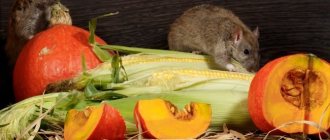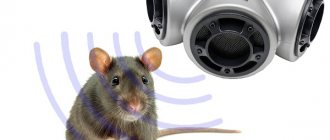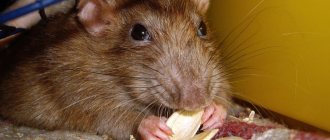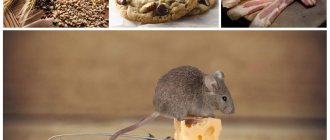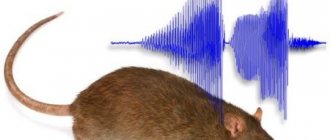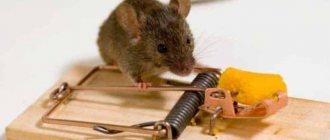Danger of rodents in the home
Behind the cute little face and smart, lively mouse eyes lies a mischievous character and a habit of gnawing on everything. In addition to food supplies, mice sharpen hard objects, this is necessary to grind down their incisors, which are constantly growing. Therefore, the walls, upholstery and frame of the sofa, interior items, etc. will be damaged. The most dangerous thing is the wiring; mice are very attracted to the smell of wire winding, and damage to the insulation leads to short circuits and fires.
What danger do mice pose?
- Infections . Rodents are carriers of salmonellosis, leptospirosis, bartonellosis, tularemia, toxoplasmosis, hantavirus infection, and pathologies caused by arenaviruses. All these diseases are dangerous for humans.
- Food poisoning . Products, incl. vegetables in the basement, over which mice ran, are literally covered with their excrement, wool, and skin particles. If you eat poorly processed foods, you can get gastrointestinal upset and allergies.
- Fleas . Rat fleas and ticks are a source of infectious diseases and constant itching. It is almost impossible to remove rat (mouse) mites from a room; even City checkers and sulfur mites, which literally burn everything around, do not help. With the onset of heat, blood-sucking insects attack people during sleep, leaving allergic blisters on the body,
An unpleasant specific smell hovers where there are mice. It is almost impossible to get rid of it, because... it eats into materials, house siding, excrement, urine remains in inaccessible places.
Important! A surefire remedy for mice in the country is to remove the source of heat and food supply. This means that clothes, mattresses, and pillows need to be hidden in sealed chests for the winter. And take the food with you, or store it in a concrete/stone underground, where rodents cannot penetrate.
Why do mice appear?
If there are mice in the country house, this may mean that the house has all the conditions for their comfortable living. Owners often notice that in the summer there are no mice, and with the onset of cold weather, hordes of mice literally attack the room, rustle behind the walls, and gnaw on food. If their population is large, they cease to be afraid of people and scurry about underfoot in broad daylight.
Such seasonality is justified - voles in the country from spring to autumn feed on grains and plant seeds, they do not need to enter the house; they find food, warmth, and shelter for breeding offspring in nature. As soon as the cold weather sets in, the need for self-preservation appears; mice rush to places where they can wait out the winter.
How to scare away mice in the country: a list of the best methods
For centuries, rodents have accompanied people; the latter have always been forced to share shelter and food with them. Awareness of the danger, especially when a connection was established between the presence of rats/mice and the spread of plague across continents, forced people to invent ways to exterminate them.
Biological method
The most effective remedy is cats; in some countries, mongooses are kept for this purpose. A good cat-mouse trap can simultaneously kill up to 20 rodents. Some of them are not afraid to fight with rats that are larger than them. Mice cannot stand marks, they are afraid of the smell emanating from the animal, so they prefer to go to quieter places.
Cats are the simplest and safest means of control for humans. There is no risk of poisoning from poisons (99 percent of them are dangerous for warm-blooded animals, including the owner of the dacha himself). The lifespan of a domestic cat is up to 20 years, which means that you can forget about the problem for many years.
Poison
Fighting mice in the countryside with the help of poisons is justified if there are a lot of rodents and traces of their activity are everywhere. And the list of spoiled things grows every season.
Chemicals have immediate or delayed (cumulative) action. Preparations for the destruction of rodents are produced in the following forms:
- Gel, cream . Their palatability is average, and their attractiveness to mice is created by flavoring additives.
- Powders . Added to baits, they have no taste, odor and do not interrupt the main aroma of food.
- Briquettes. Sealed in polyethylene, they have a soft texture and bright color. They are hidden in places that are difficult for people and animals to reach (plinths, radiators, under the floor, behind wall cladding).
- Liquids . They are placed in the house as a source for drinking, but other containers must be removed from the garden.
- Spray, aerosol . Products of doubtful effectiveness, when sprayed, are designed to cause vomiting in mice, which should discourage them from moving into the garden house.
List of poisons
Their action is based on the destruction of vascular walls, provoking bleeding, suffocation, and disruption of the cardiovascular system. The most famous chemical compositions:
- "Storm", "Death of the Rat", "Nutcracker". Brodifacoum-based drugs cause suffocation, internal bleeding, and have a slow destructive effect. Mice die within 7-10 days.
- "Zookoumarin-Neo". Available in the form of a paste, it provokes internal bleeding in rodents and destruction of vascular walls. The anticoagulant (prevents blood from clotting) is very toxic to cats, dogs, and humans. After death, the mouse mummifies (dries out).
- “Blockade, “3D-Ratsid”, “Clean House”. The active ingredient bromadiolone is highly toxic, more dangerous than all other poisons.
- "Rotendant", "Ratindan", contain diphenacin. Release form: powder for preparing bait; extreme caution is used when working with poison; it is highly toxic to people and animals.
- “Efa”, a drug based on ethylphenacin, has a cumulative effect, the mice do not die immediately.
- “Tsunami”, “Ratol” - tablets destroy the cardiovascular system of the rodent, death occurs within 7-10 days.
In a country house where there are no animals, it is easier to use poisons. But you should remember that you only need to work with gloves, wash the dishes for mixing the bait thoroughly, preferably burn them, but under no circumstances throw them away with the remains. Cats and dogs die in terrible agony after licking the bowl.
How to fight?
A rat that has settled on your property can cause enormous harm, and we will try to figure out how to deal with it. The main thing is not to delay, otherwise you may lose the harvest.
Did you know? The water rat has many enemies, such as stoats, large birds of prey and even pikes.
Humane methods
One of these methods is repelling rats with special devices emitting ultrasound. The unpleasant sound irritates the pest’s hearing organs, and it leaves its home.
It is believed that rats are able to get used to this sound and return to their homes, so when choosing such a device, you should pay attention to repellers that automatically change the range and frequency of the sound.
Read also: Peony evasive (Maryin root): botanical description and medical use
There are also traditional methods of combating these dangerous rodents. Due to the fact that the animal has a very well developed sense of smell, influencing rats using odors is considered quite effective.
In order to use this option, you will need a rabbit (or other) skin, it must be rolled up, placed in a hole and set on fire. Due to the strong stench, rats will either suffocate or leave their homes forever.
You can prepare a mixture of water and ash and pour it into underground passages. On the one hand, this will block the movement of the pest, and on the other, the unpleasant smell will also play a role.
Radical ways
The water vole is a rather cunning animal, so methods of dealing with it must be carefully thought out. Radical methods include all kinds of poisons.
Chemicals are best used in the fall or spring, during the breeding season of rodents. It is not enough to simply spread the poisonous substance around the garden plot, but it is necessary to carefully disguise it.
In the fall, it is best to add poison to the grain and spread it in front of the entrances to the burrows. In spring, bait is best made from grated potatoes, carrots and pumpkin. Oatmeal and peas are also suitable for masking.
Important! Poison baits are very toxic; do not use this method if you have pets that roam freely around the area.
You can make bait with your own hands; to do this, you need to take alibaster or gypsum, sunflower oil and flour, mix with a wooden stick until a thick mass is formed and place the container with it at the exit of the hole.
Then the integrity of the poison is observed; if traces of a rodent are noticeable, you can fill the passages with soil, and the bait should be left for some time to make sure that all rodents are exterminated.
When using radical methods, it is necessary to take into account the fact that the corpses of poisoned animals can be scattered throughout the garden. They must be identified and burned as early as possible to prevent toxic substances from penetrating the soil.
The effect of ultrasound: how effective are the devices?
In recent years, mouse repellers for cottages based on ultrasonic waves have become popular. Theoretically, the devices create a noise curtain in a certain space, alternating sounds that are unpleasant for rodents. Constant changes in tone create discomfort, forcing mice to leave their nests.
To choose the right device you need:
- Take into account the range of frequencies that the ultrasound device emits. With frequency capture up to 20 kHz, it will be audible to the human ear, and it will be impossible to be near the repeller.
- Choose with a change in tone. Night/day mode, several “melodies” so that the mice don’t get used to it.
The most popular devices: “ElectroCat”, “Tornado-400 (1200)”, “Grad A-100”, they operate for at least 2 months, create anxiety among rodents, forcing them to leave the premises. But, after the ultrasound device is removed, new generations of mice return.
Scaring away is a safe option
Various rodent repellents are good for summer cottages. After all, even in ancient times, bird-scaring structures were placed in the fields.
- Dark plastic bags. Hang used bags on the lower branches of the tree. When there are gusts of wind, they will sway and create rustling sounds that will scare away rodents.
- Black cardboard circles. The color of black cardboard will be clearly visible on white snow. The wind will shake the hanging black paper boxes and the hares will not go to the tree.
- Cans. Make holes in the tin can and, using a rope threaded through the hole, hang it on a branch. Several cans will emit loud noises when they touch, which will scare away uninvited guests.
- Bright fabric ribbons. The garden plot will look whimsical if multi-colored ribbons are tied to the lower branches. By hesitating, they will also repel rodents.
- Plastic bottles. Tied bottles with holes and mothballs placed in them can protect trees from attacks by hares and wild rabbits.
Traps
Traps, bottles, containers with a flimsy bottom, glue traps - all this gives little effect and allows the gardener to get rid of 1-3 mice that accidentally entered the house. More often, young animals end up there, and pregnant females are cautious, so it is completely impossible to eradicate mice in the country using traps.
Important! The danger with glue traps is that they trap pets instead of rodents. Kittens and puppies die, an adult can only be removed with a piece of skin and meat, so such traps are installed in an empty house for the winter.
Water voles: appearance and distribution
Water voles are sometimes called water rats or mice, but, strictly speaking, they have a very indirect relationship with these rodents, despite their external resemblance to them. These animals actually belong to the hamster family, although they bear little resemblance to the familiar domestic hamsters. Water voles look about the same as common voles, but they are noticeably larger. An adult can reach 15–25 cm, with the tail making up most of its length.
Water voles prefer to live in wetlands
This animal has thick, fluffy dark gray fur from the beginning of its short muzzle to the base of its tail, which is covered with hair and has a small tassel at the end.
You can meet the vole almost throughout the entire territory of Eurasia - right up to Siberia and the North Caucasus. Most of all, she likes marshy areas and the banks of reservoirs, but fields, meadows and even vegetable gardens are also excellent for their life. These animals are very tenacious and prolific, so nothing threatens their spread.
Read also: Home flower Hoffmania: maintenance and care
Damage caused by voles
If your summer cottage is located in a rural area, especially near rivers, lakes and swamps, prepare for the appearance of uninvited guests. Water voles, despite their name, live well in drier areas, including farms, vegetable warehouses, granaries, home gardens and vegetable gardens.
Small depressions (burrows) will appear in your area if water voles appear there
Video: rodent nutritional features
Folk remedies for rodent control
If you don’t want to use poisons or ultrasound, you can try folk remedies for mice in the country. Their action is based on rodents’ rejection of certain odors and irritating properties.
Herbs - mint, tansy, wormwood, cilantro; rodents do not like the smell of these herbs, and if you hang bunches of fresh plants around the house, you can drive out uninvited guests.
Birch tar emits a pungent odor, is very corrosive, and remains indoors for a long time if you moisten a rag with it. The disadvantage of this method is that things in the house can also adsorb the smell, especially in a room closed for the winter; it is difficult to ventilate it.
Fumigating the room with a pod of hot pepper or a piece of fur from a killed mouse does not give any effect. As long as there is smoke, the mice do not come; as soon as it becomes fresh, they return. A similar problem appears after using a sulfur or peat bomb.
Ash scattered on the floor has little effectiveness. Sticking to the paws, fur and getting into the gastrointestinal tract after licking, it disrupts the functioning of the digestive tract. The pads of the paws become irritated. All this may force mice to avoid the dangerous area, but will not force them to leave the dacha.
Damage from rodents on the site
Uninvited guests cause significant damage to the garden plot. Neglecting precautions in the fall, in the spring you can find only bare trunks of young seedlings and gnawed branches of older trees on the site. Young shoots of fruit trees, their bark and roots are a special treat for rodents, which can significantly reduce the yield of a fruit-bearing tree or completely destroy a young seedling, because damage to the bark and wood pulp disrupts sap flow, the tree does not receive the necessary water and nutrients from the soil and quickly dries out .
Quite often one can observe such a phenomenon when, it would seem, the tree has survived, the bark and branches are not gnawed, and the buds do not bloom, the leaves do not come out. Most likely, such a seedling was attacked by water rats, moles or mice, which, while feeding, gnaw at the root system. Having dug such a plant out of the ground, you can practically not detect the root system or see only its remains. The tree will most likely die if measures are not taken to “treat” it.
